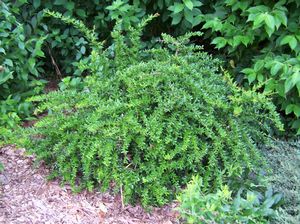Printed at http://www.quackingrassnursery.com/index.cfm/
Berberis candidula
Paleleaf Barberry
Plant Type:
BROADLEAF EVERGREEN SHRUBSBerberis candidula – Cloaked in glossy oblong deep evergreen leaves from whitish stems this low-grower makes one tough plant as a foundation candidate, a fill-in shrub between taller companions, may be used as a low hedge or even in the rock garden. The foliage of Paleleaf Barberry takes on usually bronze tones when the weather cools but for one winter season when it turned a striking bright red. Pretty yellow flowers peak from between leaves in spring and sometimes again in late season. Ours is slowly spreading stoloniferously as it gradually forms a formidable ground cover – we love this little plant! It has not set berries for us yet. Site this fantastic little Barberry in moist, fertile slightly acid to neutral Ph soils planted in full to part sun. Cutting grown.
Characteristics and Attributes for Berberis candidula
Season of Interest (Flowering)
- Summer
Season of Interest (Foliage)
- Four Seasons
Interesting Bark
- Barbed
Autumn Interest
- Autumn Leaf Color
Light
- Morning Sun / Afternoon Shade
- Full Sun
Attributes
- Massing
- Foundation
- Border
- Rock Garden
- Edging
- Shrub Border
- Evergreen
- Ground Cover
Growth Rate in the Garden
- Medium
Soil
- Fertile
- Moist
Origins
- China
Propagated By
- Cutting Grown
Genus Overview: Berberis
There are many terrific barberry species. In fact, nearly all are not a weed problem. The following are a handful of member of the genus that have proven worth and muster in northeastern Connecticut, both in utility and multi-season beauty. Some are virtually evergreen, others have wonderful autumn foliage colors and the berries range in varying colors - from blue with a whitish bloom to bright crimson. All are cutting grown. And one is a north temperate New World plant,,, yes, there are North American native barberries.



